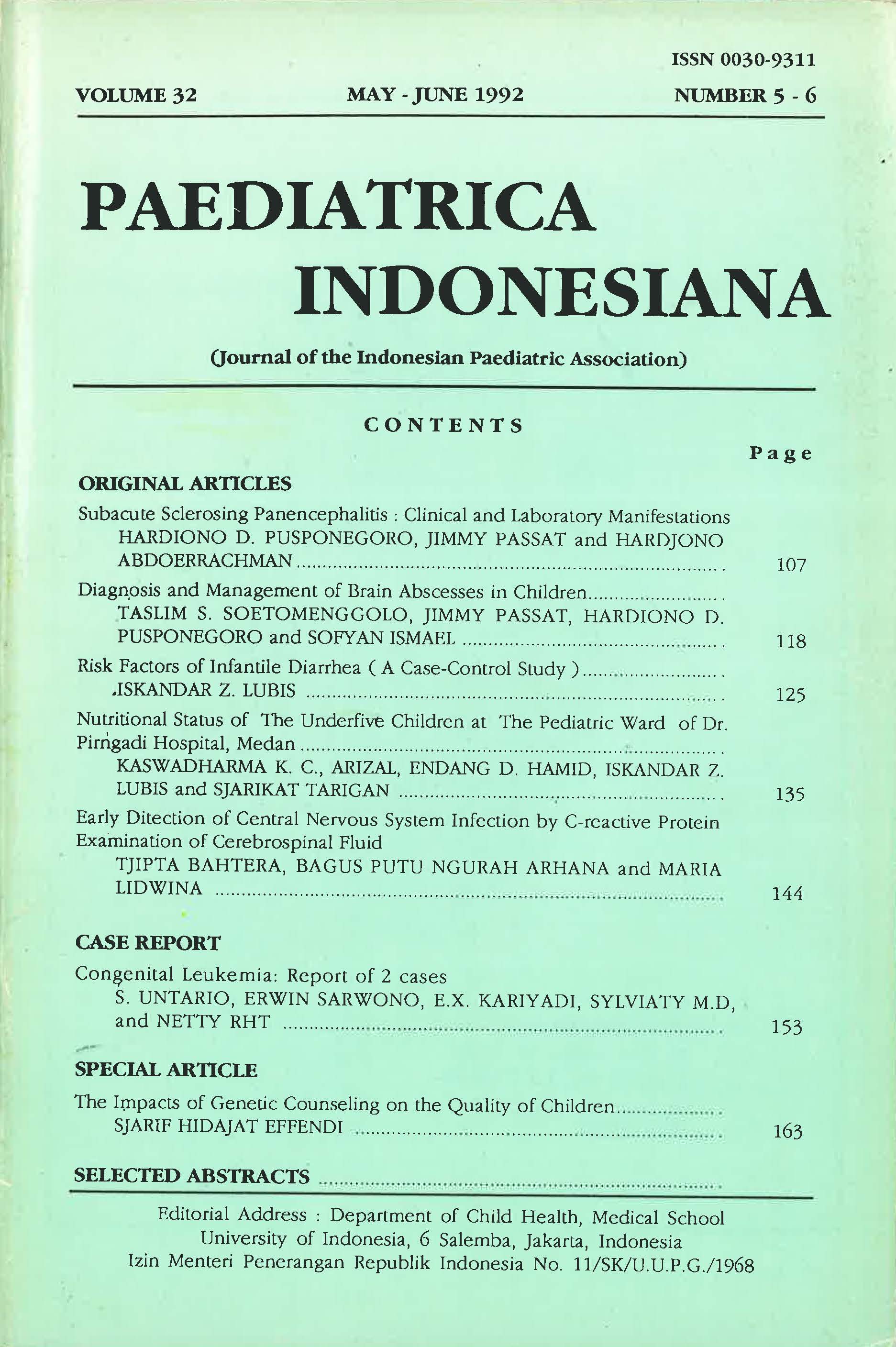Risk Factors of Infantile Diarrhea (A Case-Control Study)
DOI:
https://doi.org/10.14238/pi32.5-6.1992.125-34Keywords:
infantile diarrhea; bottle feedingAbstract
From March thru April 1990 an unmatched case-control study had been conducted at the pediatric out-patient Clinic of Dr. Pirngadi Hospital Medan to assess risk factors of infantile diarrhea. The study population were infants, aged younger than 21 months. The mothers of the infants were interviewed, using structured questionnaires.
Sample size, calculated by means of formula, with 95 % level of confidence, 90 % power of study, 50% estimated proportion of exposure in the control-group and 2.0 estimated odds ratio, was 121.
All infants with diarrhea were included in the case-group until a total number of 124 infants were reached. One control, an infant without diarrhea, was taken for each case from the nearest sequence of attendance after the case. A total of 20 risk factors were tested. Exposure was indicated from the last day before illness.
Computerized statistical analysis was performed to calculate odds ratio, 95 % confidence interval and two tailed significance testing for qualitative dichotomic data by means of Chi square test.
A total of nine factors were confirmed as risk factors of infantile diarrhea i.e mothers age than 20 years, working mother, not cleaning nipple before suckling the baby bottle feeding, having only one nursing botlle/teat, not ready for use nursing bottle/teat, giving left over supplementary food without reheating, no band-washing before giving supplementary food and malnutrition.
The result of this study can be emphasized in health education, especially in diarrheal disease control of infancy; Further well-designed studies are needed.
References
2. Winardi B. Aspek kesehatan masyarakat dari penyakit diare. National Seminar on Rehidration, Jakarta
(1983).
3. Sunoto. Pendekatan diagnostik-etlologik diare akut. Continuing Pediatrics Education : Penanganan mutakhir beberapa penyakit gastrointestinal anak, pp. 1-22 (FKUI, Jakarta 1988).
4. Hartono G. Peranan pemberantasan penyakit diare dalam peningkatan kualitas hidup dan kelangsungan hidup anak di Indonesia. Presented in PIB XI BKGAIJakarta (1989).
5. WHO. Improving infant feeding practices to prevent diarrhoea or reduce its severity – Research issues. WHO/CDD/EDP/88.1
6. Sunoto. Upaya menurunkan morbiditas diare. Presented in PIB XI BKGAI Jakarta (1989).
7. Sugitha et al. Beberapa faktor yang mempengaruhi kejadian diare pada anak sampai usia 1 tahun. Presented in PIB VIII BKGAI Semarang (1982).
8. Lubis I Z. Identifikasi faktor risiko terjadinya diare pada bayi. Presented in PIB XI BKGAI Jakarta 1989. Medika no.2, ed.17; 1991: 106-9.
9. Kirkwood B R. Calculation of required sample size. In; Kirkwood, ed. Essensials of medical statistics, Oxford: Blackwell Scientific Publication, 1989.
Downloads
Published
How to Cite
Issue
Section
License
Authors who publish with this journal agree to the following terms:
Authors retain copyright and grant the journal right of first publication with the work simultaneously licensed under a Creative Commons Attribution License that allows others to share the work with an acknowledgement of the work's authorship and initial publication in this journal.
Authors are able to enter into separate, additional contractual arrangements for the non-exclusive distribution of the journal's published version of the work (e.g., post it to an institutional repository or publish it in a book), with an acknowledgement of its initial publication in this journal.













